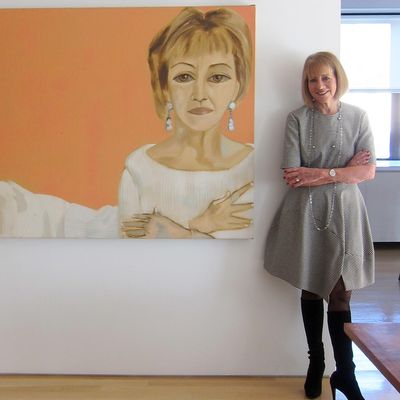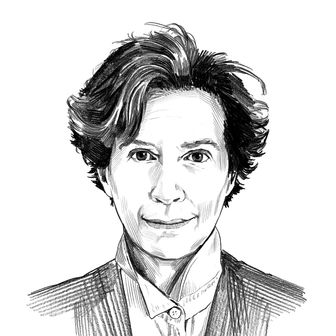
A few weeks ago, Lisa Dennison, the head of Sotheby’s in North and South America, told me that she owned a truly significant work of art — a portrait by Francesco Clemente. Early one morning last week, I went to visit her at home, to find out what it was like for her to sit for it. We sat down in her living room as she told me the story.
I did a retrospective at the Guggenheim of Clemente, and one of the icons of the show was this portrait that he did of his wife, Alba, in this exact format — eight feet long and four feet high. The colors, the expression, really, while it was perfectly Alba, it also embodied all the ideas that he plays with in his art. The idea of distortion, of these huge eyes being the window into the soul, and also a love of color and a love of sort of the decorative element, like the shimmer of a jewel.
We had a double kind of show opening; one night it was the big fancy opening, and I think the night before we had a smaller dinner that we did for really VI-VIPs and his friends in the center of the rotunda, and at the end of that night, he came up to me and he said, “Thank you so much for doing this show, and to thank you, and for your birthday” — because my birthday was coming up — “I want to paint your portrait. So I thought, Well, does he mean the eight-foot? Or, does he mean one of his beautiful watercolors? Because he also does these exquisite smaller watercolors, and he said, “No, it’s the eight-foot,” and he said, “You’ll come to my studio for a sitting. You need to wear beautiful things.” I realized that, in all of his portraits, it was all about the shoes — like every single female portrait wore Manolo Blahnik shoes, because you kick your feet up.
What’s interesting about the format is that the feet equate to the head; it’s a very balanced composition, which, of course, is completely distorted and attenuated in a kind of Egon Schiele way, but you have the head balanced by the foot.
He also said to me, “You’ll have no control.” And I said, “Well, I just want to tell you one thing: I love color.” Because he had done a lot of portraits that had black backgrounds or brown grounds, and I wanted something that had color. But you can’t say, “I want blue, I want green, I want yellow.” I just said, “If there is any way I can influence you, I’d love to have some color.” He said, “I hear you, but you know, you have no say.” And he said, “It’s going to be four hours, start to finish, and at the end of four hours, maybe sometimes it takes five hours, I’m exhausted, and then we’ll go and have some lunch.” And he said, “During that time you just have to be completely still, and you can’t talk.”
One of the things I learned about Francesco is that we would spend a lot of time planning the show in pure silence where we would just sit and look at a painting, or sit and contemplate, and I remember we once visited him in Taos, and I was mesmerized, sitting on his porch, looking at just fields and fields of sage bush and grass, and I was just so calm, and he said, “I’ve never known you to go this long without talking.” At the beginning I was so nervous, I felt like I was the curator. I sit there and talk, talk, talk. So it’s very Zen and you have no idea what’s happening. You sort of watch and you try to read the gestures of the arm, but you’re just sitting and there is never a peak, nothing. It’s amazing; it’s a really huge canvas, and the whole thing gets done in four hours, and it was four hours.
He positions you. He really does position you, and then there’s a certain amount of artistic license taken.
And then, all of a sudden, it’s over, and you have this moment of reveal. I remember at the time it was such an extraordinary experience, trying to read what I could from watching him dip his paint on to the palette, which looked to me nothing like the color it was going to turn out to be, and I remember there being very few colors on the palette and wishing that, is there really going to be color? Is there really going to be variation? Because it looks like there are three colors there. He just wrought so many more colors than I expected.
You have this four hours where you are in a dream, where you are watching, and listening to his breathing, and watching the gesture of the painting, and watching the brush being dipped, because you can see that, and there is a lot of paint on the floor. He paints very low down, and he has paint pots on the floor, glass jars, and then, and then, it’s over. He said, “It’s done.”
I loved it. First of all, the color. It was everything I could dream of in a color. You know, my favorite color in the world is pink. I live for pink. I get a visceral reaction to pink. But it was kind of a rosy, pinky-orangey color that I thought was so flattering. Also I was so excited because it really perfectly fit in the scheme of the apartment, and sort of the palette I had. I couldn’t have asked for anything more. It was a shock, a total shock, and it was just miraculous.



